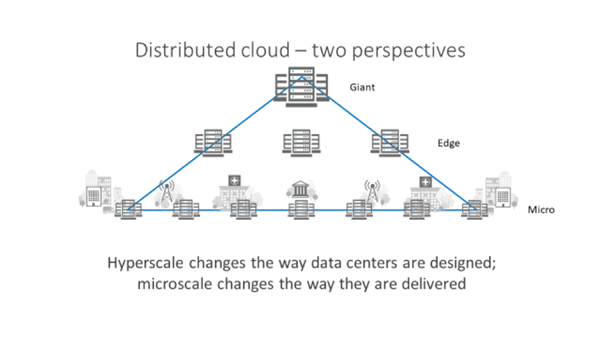Massive growth in smartphones and video streaming together with the emergence of the IoT, big data and AI, have brought us to the current era of hyperscale data centers. Today nearly half of the world’s data is stored and processed in around 350 of these enormous and highly scalable facilities.
But is this trend simply set to continue with the hyperscalers building more and larger data centers every year? The answer is that, while there may well be 500 of these massive facilities by 2020, that’s only going to be part of the story. The industry has figured out that things won’t work if all data is centralized in a small number of locations. That’s why the big swing is now towards “edge data centers.”
Enhancing cost-efficiency and performance with edge data centers enables the kind of end-to-end solutions needed in the emerging digital landscape. Sending lots of data long distance is expensive and so latency-critical, high-capacity services need to be local. Regulatory requirements and security considerations also come into play – local usually means more secure and a lot of very sensitive data is not permitted to travel between countries.
Moving closer
Several companies, mostly in the US, have begun to address this need for close proximity. The likes of DartPoints and EdgeConneX have developed a business model based on building small edge data centers to provide hosting capability for the hyperscalers. An example of this type of colocation data center belongs to DARZ in Darmstadt, Germany. Built in what was once the federal state bank, this facility has been successfully and very securely hosting data at the edge of the network for three years.
Network operators are also getting involved. AT&T’s Andre Fuetsch pointed out how carriers are actually uniquely positioned to get in on the game as they can convert central offices and local exchanges into distributed computing facilities. Of course, these have the advantage of already being conveniently close to customers.
Growing smaller
What’s great from our perspective at ADVA is that all of these edge facilities need connectivity. One edge hosting model that we’re already very familiar with goes even further. It is the universal customer premises equipment (uCPE) white box solution. This develops the edge data center model on a much smaller scale. Multiple customers can be served or this type of micro data center can involve as little as a single server.
And it isn’t confined to the service provider world. Micro data centers can be essential for certain enterprise verticals such as oil and gas exploration. When exploring an oil field, terabytes of data are collected about temperature, pressure, resistance, etc. The challenge here is sharing information quickly and edge computing on the oil platform can speed this process up dramatically by pre-processing.
Getting foggy
The growth in distributed compute and storage also creates other opportunities. Spare cloud capacity can be rented, giving rise to another phenomenon known as “fog computing.” When these surplus resources become connected and available, it will create many new avenues for business. Several groups are already looking into leveraging extra cloud capacity for IoT, 5G and AI applications.
Clouds on the horizon
The hierarchy of the distributed cloud can be viewed in two ways. We can see it from the top to the bottom, all geared towards the big guys. Alternatively, it can be looked at from the bottom up, based on a multiple-node model with capacity built precisely where it’s needed.

What both approaches have in common is that they follow the hyperscale architecture. And, what they both rely on is superb connectivity. That means high security, low latency and, in some cases, ultra-fast speed. As the cloud gets more distributed, the links that bind it together will be all the more crucial.
Back in the network operator world, one particularly interesting distributed cloud initiative is the central office re-architected as a data center (CORD). CORD is all about service providers adopting hyperscale architecture to harness data center economies and cloud agility for their residential, enterprise and mobile customers – and it’s this I’ll be diving into in next week’s blog post.
